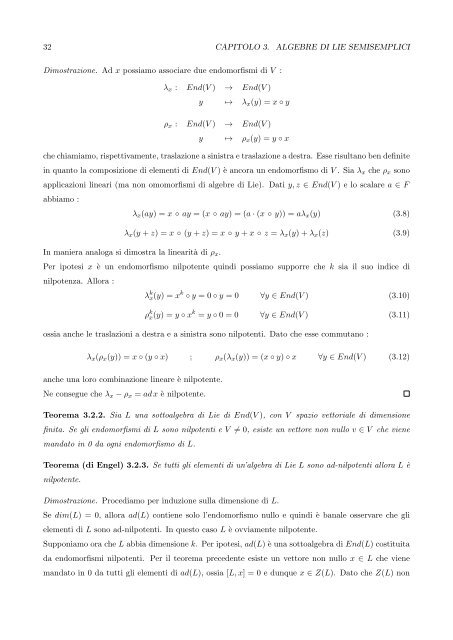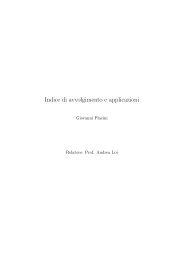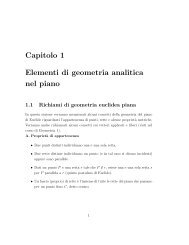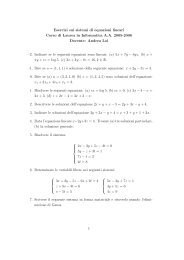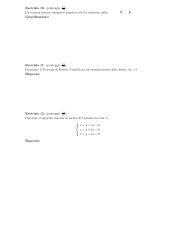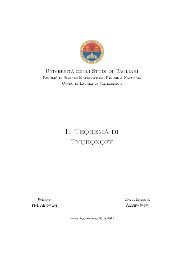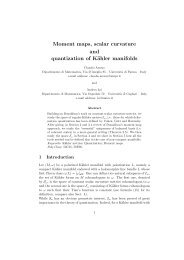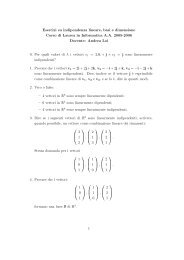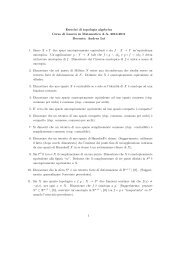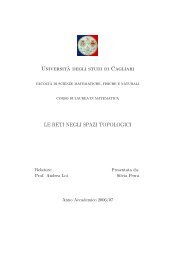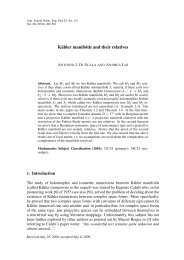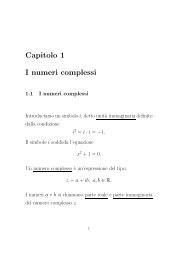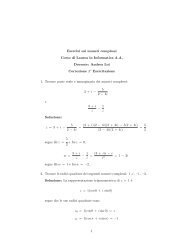Algebre di Lie semisemplici, sistemi di radici e loro classificazione
Algebre di Lie semisemplici, sistemi di radici e loro classificazione
Algebre di Lie semisemplici, sistemi di radici e loro classificazione
You also want an ePaper? Increase the reach of your titles
YUMPU automatically turns print PDFs into web optimized ePapers that Google loves.
32 CAPITOLO 3. ALGEBRE DI LIE SEMISEMPLICI<br />
Dimostrazione. Ad x possiamo associare due endomorfismi <strong>di</strong> V :<br />
λx : End(V ) → End(V )<br />
y ↦→ λx(y) = x ◦ y<br />
ρx : End(V ) → End(V )<br />
y ↦→ ρx(y) = y ◦ x<br />
che chiamiamo, rispettivamente, traslazione a sinistra e traslazione a destra. Esse risultano ben definite<br />
in quanto la composizione <strong>di</strong> elementi <strong>di</strong> End(V ) è ancora un endomorfismo <strong>di</strong> V . Sia λx che ρx sono<br />
applicazioni lineari (ma non omomorfismi <strong>di</strong> algebre <strong>di</strong> <strong>Lie</strong>). Dati y, z ∈ End(V ) e lo scalare a ∈ F<br />
abbiamo :<br />
λx(ay) = x ◦ ay = (x ◦ ay) = (a · (x ◦ y)) = aλx(y) (3.8)<br />
λx(y + z) = x ◦ (y + z) = x ◦ y + x ◦ z = λx(y) + λx(z) (3.9)<br />
In maniera analoga si <strong>di</strong>mostra la linearità <strong>di</strong> ρx.<br />
Per ipotesi x è un endomorfismo nilpotente quin<strong>di</strong> possiamo supporre che k sia il suo in<strong>di</strong>ce <strong>di</strong><br />
nilpotenza. Allora :<br />
λ k x(y) = x k ◦ y = 0 ◦ y = 0 ∀y ∈ End(V ) (3.10)<br />
ρ k x(y) = y ◦ x k = y ◦ 0 = 0 ∀y ∈ End(V ) (3.11)<br />
ossia anche le traslazioni a destra e a sinistra sono nilpotenti. Dato che esse commutano :<br />
λx(ρx(y)) = x ◦ (y ◦ x) ; ρx(λx(y)) = (x ◦ y) ◦ x ∀y ∈ End(V ) (3.12)<br />
anche una <strong>loro</strong> combinazione lineare è nilpotente.<br />
Ne consegue che λx − ρx = ad x è nilpotente.<br />
Teorema 3.2.2. Sia L una sottoalgebra <strong>di</strong> <strong>Lie</strong> <strong>di</strong> End(V ), con V spazio vettoriale <strong>di</strong> <strong>di</strong>mensione<br />
finita. Se gli endomorfismi <strong>di</strong> L sono nilpotenti e V = 0, esiste un vettore non nullo v ∈ V che viene<br />
mandato in 0 da ogni endomorfismo <strong>di</strong> L.<br />
Teorema (<strong>di</strong> Engel) 3.2.3. Se tutti gli elementi <strong>di</strong> un’algebra <strong>di</strong> <strong>Lie</strong> L sono ad-nilpotenti allora L è<br />
nilpotente.<br />
Dimostrazione. Proce<strong>di</strong>amo per induzione sulla <strong>di</strong>mensione <strong>di</strong> L.<br />
Se <strong>di</strong>m(L) = 0, allora ad(L) contiene solo l’endomorfismo nullo e quin<strong>di</strong> è banale osservare che gli<br />
elementi <strong>di</strong> L sono ad-nilpotenti. In questo caso L è ovviamente nilpotente.<br />
Supponiamo ora che L abbia <strong>di</strong>mensione k. Per ipotesi, ad(L) è una sottoalgebra <strong>di</strong> End(L) costituita<br />
da endomorfismi nilpotenti. Per il teorema precedente esiste un vettore non nullo x ∈ L che viene<br />
mandato in 0 da tutti gli elementi <strong>di</strong> ad(L), ossia [L, x] = 0 e dunque x ∈ Z(L). Dato che Z(L) non


